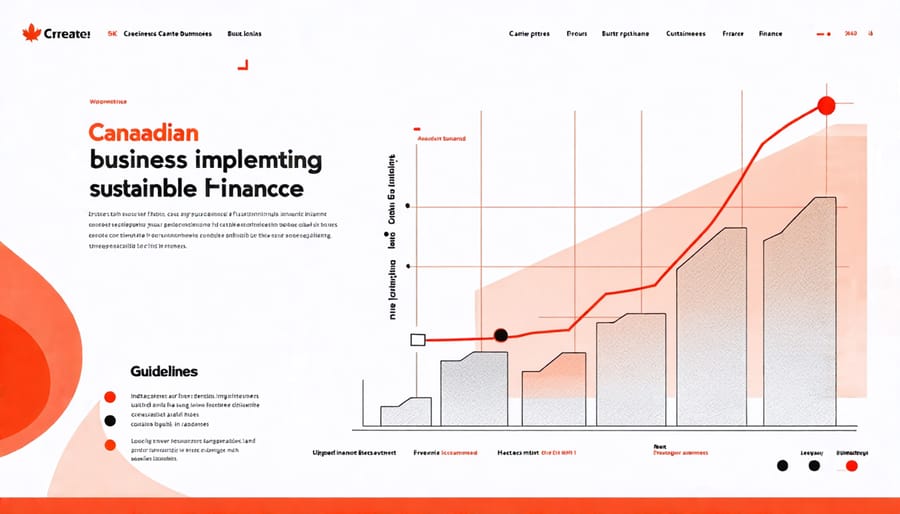Implement green financing by seeking out banks and institutions that prioritize environmental responsibility and offer special loan terms for sustainable initiatives. Explore government grants and programs dedicated to supporting eco-friendly small businesses, which can significantly reduce upfront costs and financial barriers. Develop a sustainability strategy by identifying specific areas for improvement, such as energy efficiency, waste reduction, or sustainable sourcing, and establish clear goals to measure progress. Network with industry peers and join associations focused on sustainability to share knowledge, learn best practices, and uncover collaborative opportunities.
Understanding Sustainable Capital Finance
Defining Sustainable Finance
Sustainable finance refers to financial practices that consider environmental, social, and governance (ESG) factors alongside traditional financial metrics. Unlike conventional finance, which focuses primarily on maximizing short-term returns, sustainable finance aims for long-term value creation while promoting positive societal impacts. For Canadian small business owners, this means adopting financial strategies that support both business goals and community well-being.
Embracing sustainable finance can lead to numerous benefits, such as enhanced reputation, increased access to capital, and risk management by addressing climate-related challenges. For aspiring entrepreneurs, integrating sustainability into their financial planning can attract investors who prioritize responsible practices. The path to sustainable finance involves evaluating your business’s ESG impacts, setting clear objectives, and reporting progress transparently.
By aligning with sustainable finance principles, small businesses in Canada are not only contributing to a healthier planet but are also positioning themselves for future growth and resilience in an evolving economic landscape.

Core Principles of Sustainability in Finance
Sustainable capital finance focuses on integrating environmental, social, and governance (ESG) principles into financial decisions, benefiting both the planet and businesses. For Canadian small business owners, embracing these core principles can open doors to new opportunities and strengthen their market position.
Environmental considerations involve assessing the impact of business activities on the planet. This might include energy efficiency, waste reduction, and sustainable resource use. By adopting eco-friendly practices, businesses not only reduce their carbon footprint but also enhance their reputation among consumers who value sustainability.
Social impact centres on the business’s effect on its community and stakeholders. This means prioritizing fair labour practices, community engagement, and inclusivity. Businesses demonstrating social responsibility can attract talent and foster customer loyalty, thus driving long-term success.
Governance involves the frameworks, policies, and practices that ensure a business operates responsibly and transparently. Good governance mitigates risks and strengthens trust with investors and partners. For instance, clear communication of sustainable goals and progress can make a business more attractive to ethically-minded investors.
Small business owners can take actionable steps by starting with a sustainability assessment and setting clear ESG goals. Leveraging sustainable finance not only helps businesses thrive but also positions them as leaders in the transition towards a greener economy.
Why Canadian Small Businesses Should Care
Benefits of Sustainable Finance
Embracing sustainable finance offers a myriad of benefits for Canadian small businesses, driving both immediate and long-term success. Firstly, investing in sustainable practices can lead to significant cost savings. By reducing energy consumption or minimizing waste, businesses can cut down on operational expenses. For example, a small café in Toronto switched to energy-efficient appliances and saw its electricity bill reduced by 30%, freeing up funds to reinvest in other areas of the business.
Moreover, sustainable finance improves a company’s reputation. Customers today are more environmentally conscious and prefer to support businesses that align with their values. Showing a commitment to sustainability can not only attract more customers but also enhance brand loyalty. It’s not just theory—a Vancouver retailer grew its customer base by 20% after implementing sustainable initiatives.
Finally, sustainability offers a competitive edge. Businesses that integrate sustainable practices often innovate by necessity, leading to unique products or services that stand out in the market. In an ever-evolving business landscape, these advantages can be the key to thriving amidst competition.

Aligning with Canadian Policies and Trends
Navigating the evolving landscape of sustainability regulations in Canada can seem daunting for small business owners and aspiring entrepreneurs. Yet, aligning with these policies offers significant benefits and supports your readiness to tap into growing consumer trends favoring eco-friendly practices. Canada is actively promoting sustainability through various initiatives and regulations, offering pathways for businesses to drive sustainable growth. By adopting sustainable capital finance, you’re not only meeting these regulatory requirements but also enhancing your business’s appeal to environmentally-conscious consumers.
One practical step is leveraging eco-friendly grants to fund your green initiatives, ensuring a competitive edge in the marketplace. Businesses that have successfully integrated sustainable finance report increased customer loyalty and improved brand reputation. As you consider this approach, view it as a strategy that aligns your business model with Canada’s green policies, optimizing opportunities for innovation and long-term success. Additionally, such alignment prepares you for future regulations, turning potential challenges into strategic advantages.
Practical Steps to Implement Sustainable Finance

Evaluating Your Current Financial Practices
Evaluating your current financial practices is a crucial step towards integrating sustainable capital finance into your business strategy. Start by analyzing your existing financial operations to pinpoint inefficiencies or unsustainable elements. Are there areas where energy use is high, or partnerships that may not align with environmental goals? Examining these can offer insights into where improvements can be made. Consider tracking metrics that go beyond profit, such as environmental impact and social contribution, to get a holistic view of your business’s sustainability.
Engage your team in this reflective process, encouraging them to provide input based on their daily experiences. Their unique perspectives can uncover overlooked aspects that need attention. For instance, a local bakery might discover that sourcing ingredients from nearby sustainable farms not only reduces their carbon footprint but also supports local economies.
By clearly identifying areas for improvement, you can create a roadmap for integrating sustainable practices that align with both your financial goals and environmental responsibilities. This proactive approach fosters a resilient and forward-thinking business model, enhancing both sustainability and profitability in today’s market.
Developing a Sustainable Finance Strategy
Developing a sustainable finance strategy for your small business involves a thoughtful balance between pursuing growth and adhering to environmental and social responsibilities. To begin, define your sustainability goals clearly. Consider how reducing your carbon footprint or improving social equity fits into your long-term vision. Another critical step is conducting a thorough assessment of your current operations to identify areas where sustainable practices can be integrated. For instance, if your business relies on energy-intensive processes, consider investing in energy-efficient technologies or renewable energy sources.
Ensure the strategy aligns with your business goals by integrating sustainability into your core business model. This could involve building sustainability initiatives into your mission statement or product development processes. One common success story comes from Canadian retailers who have successfully reduced waste and increased customer loyalty by adopting reusable packaging.
Engage your team and stakeholders early in the strategy development process. Their input can offer valuable insights and promote a culture of sustainability throughout your organization. Consider seeking free financial help to support your sustainable initiatives.
Lastly, set measurable targets and regularly evaluate your progress. Use these assessments to refine your strategy over time. By committing to sustainable finance practices, you not only contribute positively to the planet but can also enhance your brand’s reputation and appeal to conscientious consumers.
Real-Life Success Stories
In the heart of British Columbia, a small eco-friendly packaging company proved that sustainable capital finance could transform not just their operations but their entire future. By tapping into green finance options, they were able to fund pivotal upgrades to their production processes. This shift not only slashed their carbon footprint but also unlocked new partnership opportunities with larger corporations dedicated to sustainability. Their success story has inspired countless Canadian entrepreneurs to explore similar pathways, reinforcing the idea that going green makes sound business sense.
In Quebec, a artisanal bakery realized their dream by leveraging community-focused investment funds. This step allowed them to install energy-efficient equipment, significantly reducing energy costs. Through involvement in local networking groups, the bakery expanded its reach and gained insights on sustainable practices. Their journey highlights how joining forces with like-minded businesses can multiply the benefits of sustainable capital investments.
Additionally, a tech start-up in Toronto utilized sustainable finance to develop software reducing energy consumption in urban buildings. This innovation caught the eye of reputable investors and led to rapid growth, demonstrating that eco-conscious ventures attract not only consumer interest but also promising funding opportunities. These stories illustrate that Canadian businesses, regardless of size or sector, can thrive by integrating sustainable capital finance into their strategies.
Conclusion
As we draw to a close, it’s evident that embracing sustainable capital finance is crucial for the growth and resilience of small businesses in Canada. By integrating sustainable finance practices, entrepreneurs can unlock new opportunities for growth and innovation, all while contributing to a more sustainable future. This approach not only strengthens the financial standing of businesses but also enhances their reputation and community standing. Real-world examples have shown that businesses prioritizing sustainable finance are not only surviving challenging times but thriving, setting a benchmark for others. Transitioning to sustainable finance may seem daunting at first, but with step-by-step implementation and a commitment to long-term goals, it becomes a pathway to success. As small business owners and aspiring entrepreneurs navigate the dynamic economic landscape, sustainable capital finance provides a solid foundation for achieving lasting growth and resilience. With the right strategies in place, the future of Canadian small businesses looks promising and robust.
You may also like
-
Why Brazilian Betting Platforms Want to Partner with Your Canadian Business
-
Revamp Your Small Business: Digital Transformation Success in Canada
-
Transform Your Small Business with Must-Have Automation Tools
-
Boost Your Small Business with Google Analytics: A Step-by-Step Approach
-
Boost Team Spirit Fast: 5-Minute Activities for Busy Small Groups

